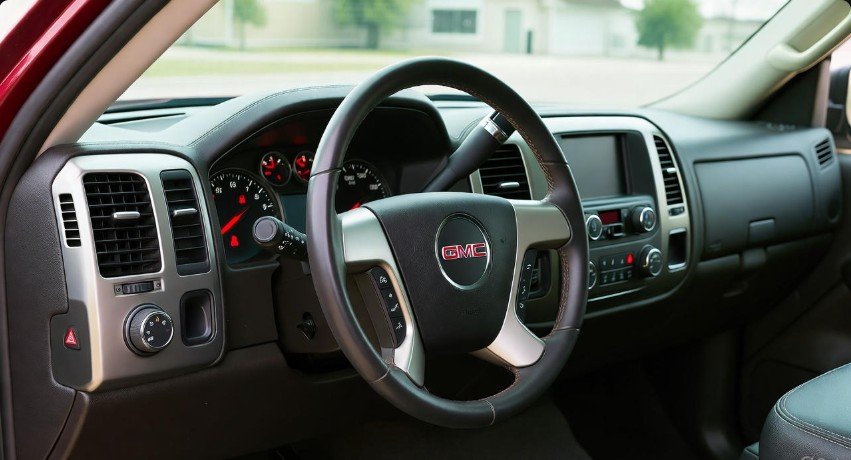Where is the TPMS Reset Button on a GMC Sierra: Easy To Find Location

Owning a GMC Sierra comes with a sense of pride and confidence. It’s a rugged, reliable truck that can handle both city streets and off-road adventures with ease. But like any vehicle, keeping it in top condition requires attention to the details—especially when it comes to safety features like the Tire Pressure Monitoring System (TPMS). The TPMS is not just a fancy gadget on your dashboard; it’s your first line of defense against underinflated tires, poor fuel efficiency, and potential accidents. If you’ve ever noticed that blinking TPMS light and wondered what to do, you’re not alone. Knowing where the TPMS reset button on a GMC Sierra is located—and how to use it—is a game-changer for every truck owner.
Understanding the TPMS Reset Button
Before diving under the dashboard, it’s worth understanding what this small yet mighty button actually does. The TPMS reset button is essentially a recalibration tool. After you inflate your tires, rotate them, or replace one, the system needs to “learn” the new pressures. Without resetting, the TPMS may continue giving warnings that don’t match the actual tire conditions. Think of it like teaching a friend a new habit—if you don’t guide them, they’ll keep giving wrong advice!
Functionally, this button sends a signal to the TPMS sensors, allowing them to adjust and synchronize with the current tire pressures. Once recalibrated, you can drive with peace of mind, knowing that the system will alert you accurately if anything goes wrong. For drivers who frequently handle heavy loads or travel long distances, this small button becomes a critical part of vehicle maintenance.
Why Location Matters: Finding the TPMS Reset Button
Now comes the million-dollar question: where is the TPMS reset button on a GMC Sierra? Depending on your model year and trim level, the location may vary slightly, but there are some common patterns. Most often, it is tucked neatly under the steering wheel near the OBD-II diagnostic port. Its recessed position isn’t a coincidence—it’s designed to prevent accidental presses while driving.
Here’s a simple approach to finding it:
-
Sit in the driver’s seat and adjust your position so you have a clear view under the steering wheel.
-
Scan the lower dash area for a small, round button. It might be labeled “TPMS Reset” or “Tire Reset”.
-
If you can’t see it immediately, check the vehicle’s owner manual. GMC often provides diagrams highlighting its exact position.
Locating this button might feel like a treasure hunt at first, but once you know where it is, it becomes second nature—just another part of your routine truck check.
Step-by-Step Guide to Using the TPMS Reset Button
Finding the button is only half the battle. Knowing how to use it correctly is what ensures your TPMS system functions properly. Here’s a straightforward process that works for most GMC Sierra models:
-
Check Tire Pressures: Make sure all tires are inflated to the recommended PSI. Underinflated or overinflated tires can affect recalibration.
-
Start the Vehicle: Keep it in “Park” or “Neutral” for safety. Turn the ignition to the “On” position, but do not start the engine.
-
Press and Hold the TPMS Button: Hold it until the TPMS indicator blinks twice. This signals that the reset process has begun.
-
Release the Button: The indicator light will illuminate for a few seconds, confirming the reset.
-
Drive to Recalibrate: Take your Sierra for a short drive. Sensors will adjust and sync with the tire pressures.
It’s a simple process, but attention to detail is crucial. Think of it as recalibrating a musical instrument—you want everything to be perfectly tuned before the performance.
Why Resetting TPMS is Essential
Some drivers may overlook the importance of the TPMS reset button, but neglecting it can have consequences. A misreading TPMS can cause:
-
Reduced fuel efficiency: Underinflated tires create drag, consuming more fuel.
-
Premature tire wear: Driving with incorrect pressure leads to uneven wear and costly replacements.
-
Safety risks: Improperly inflated tires can compromise handling and braking, especially in wet or icy conditions.
Resetting your TPMS ensures that your GMC Sierra’s sensors provide accurate alerts. It’s like giving your vehicle a health check, reassuring that every tire is in optimal shape before hitting the road.
Tips for a Smooth Reset Experience
Here are some practical tips that make resetting your GMC Sierra TPMS easier:
-
Always reset the TPMS after tire rotation or replacement.
-
Perform the reset with the engine off, using only the “On” ignition position.
-
If the light continues to blink after a reset, double-check tire pressures and repeat the process.
-
Keep the owner’s manual handy—it’s your ultimate guide for model-specific instructions.
By following these tips, you can avoid frustration and ensure the TPMS functions flawlessly.
Common Mistakes When Resetting the TPMS
Even the most experienced drivers can make small mistakes when trying to reset the TPMS on their truck. When dealing with the TPMS reset button on a GMC Sierra, it’s easy to overlook simple steps that make the process smoother. One common mistake is resetting the system before checking the tire pressures. If the tires are not inflated to the recommended PSI, the sensors will not sync properly. Another issue people face is turning the engine fully on before pressing the button. The reset process only works when the ignition is in the “On” position and the engine is off.
Some drivers also press the button for too long or too short a time, which causes the system to misread the reset signal. If the indicator light does not blink twice, the system didn’t accept the reset. And often, drivers forget to take the short drive needed for recalibration. The truck needs movement to let the sensors adjust and connect with the new tire pressures. By avoiding these simple mistakes, you ensure the reset process works with no stress and no guesswork.
How Model Years Affect the Button Location
Not all Sierra models have the exact same location for the reset button. This is why many drivers search again and again for where the TPMS reset button on a GMC Sierra is located. Older models often have a physical button near the steering column or under the dashboard. Newer models sometimes use the vehicle’s digital display menu instead of a manual button. If your truck has a touchscreen or advanced driver information center, the TPMS reset option might be available through an on-screen setting.
Newer Sierra models offer a more guided reset process through the instrument cluster. This helps reduce the chance of incorrect resets and allows the system to provide step-by-step instructions. On the other hand, older models rely only on the physical button, making it essential to find the exact spot where it’s hidden. Understanding your model year saves time and effort since you know whether to look for a real button or explore the truck’s menu.
Here is a quick comparison for clarity:
TPMS Reset Method by Model Year
| GMC Sierra Years | Reset Style | Button Location | Notes |
|---|---|---|---|
| 2007–2013 | Manual Button | Under steering wheel | Often near OBD-II port |
| 2014–2018 | Manual & Digital | Under dash or in menu | Some trims use dashboard menu |
| 2019–Present | Digital Reset | Driver Information Center | No physical button in most trims |
This helps you know exactly what to expect before you start the reset process.
Signs Your TPMS Needs a Reset
Sometimes the TPMS light blinks even when your tires are fully inflated. This is when you know you need to reset the system. One common sign is if the TPMS light stays on even after adjusting tire pressure. Another sign is a blinking TPMS light that appears only when you start the truck. This happens when the sensors struggle to communicate with the system. If you recently rotated or replaced your tires, the TPMS must be reset to adapt to the new positions of the sensors.
Weather changes can also affect the system. Cold weather lowers tire pressure, causing the TPMS to react. After inflating the tires back to normal levels, a reset might be needed. If you ever notice uneven readings or pressure alerts that don’t match your tire gauge, it’s time for a reset. These signs are like the truck whispering to you that it needs a small adjustment to perform at its best.
Why Proper Tire Pressure Matters for Your Sierra
Your GMC Sierra may be powerful, but it still depends on correct tire pressure to work safely. Proper tire pressure helps the truck maintain good balance, reduces wear, and increases fuel efficiency. Underinflated tires cause the engine to work harder, wasting fuel and reducing performance. Overinflated tires, on the other hand, affect traction and break comfort. When the TPMS system is correctly reset, it monitors the pressure for you so you don’t have to guess.
Think of tire pressure like the rhythm of a heartbeat. When the pressure is right, the truck moves smoothly and responds well. If the pressure is off, the entire driving experience feels heavier or unstable. This is why resetting the TPMS after pressure changes is not just a suggestion—it is essential for safety and comfort. Your Sierra performs at its best when the tires support it correctly.
Helpful Tips for Maintaining Your TPMS System
Maintaining the TPMS is not difficult, but consistency matters. You can make the system last longer and work more accurately by following a few simple tips:
-
Check your tire pressure every month.
-
Reset the TPMS after every tire rotation or replacement.
-
Avoid using sealants that may damage sensors.
-
Keep your tires clean from heavy mud that may affect sensor signals.
-
Replace TPMS sensors every 5–7 years or when their batteries die.
Following these tips helps you avoid future issues and keeps your Sierra running smoothly.
Bullet Points: Quick Facts to Remember
Here are simple points to help you recall the most important details:
-
The TPMS reset button on a GMC Sierra is usually under the steering wheel.
-
Some newer models use digital menus instead of a button.
-
Always check tire pressure before resetting.
-
The reset works only when the engine is off and ignition is on.
-
A blinking TPMS light means the system needs attention.
These points make it easy to keep the system working the way it should.
Frequently Asked Questions (FAQs)
1. Where is the TPMS reset button located on a GMC Sierra?
It is usually under the dashboard near the steering column. Some newer models use the driver information center instead of a physical button.
2. Do all GMC Sierra models have a TPMS reset button?
Older models do. Newer ones may only have a digital reset option.
3. Why does my TPMS light stay on after inflating the tires?
Because the system needs a reset. The sensors must be recalibrated after pressure changes.
4. How long should I press the TPMS reset button?
Hold it until the TPMS light blinks twice. This confirms that the reset signal has been accepted.
5. Can I drive with the TPMS light on?
It is not recommended. It may indicate low tire pressure, which affects safety and performance.
6. Does resetting TPMS fix sensor problems?
A reset helps with calibration, but a damaged sensor needs replacement.
7. Why does my TPMS reset not work?
Check your tire pressures first. Also confirm whether your Sierra uses a digital reset instead of a button.
8. How often should I reset the TPMS?
You should reset it after tire rotation, replacement, or inflation adjustments.
Conclusion
The TPMS reset button on a GMC Sierra may be small, but it plays a big role in keeping your truck safe and efficient. Knowing where it is and how to use it saves time, prevents frustration, and protects your tires. Whether your Sierra has a manual button under the steering wheel or a digital reset option in the dashboard menu, the process is simple once you understand it. Resetting the TPMS ensures your sensors stay accurate and respond to pressure changes the way they should.
With proper tire pressure and a correctly working TPMS, your Sierra delivers smoother rides, better fuel economy, and stronger performance. Treat your TPMS as part of your regular truck care routine, and it will always help you stay safe on the road.





